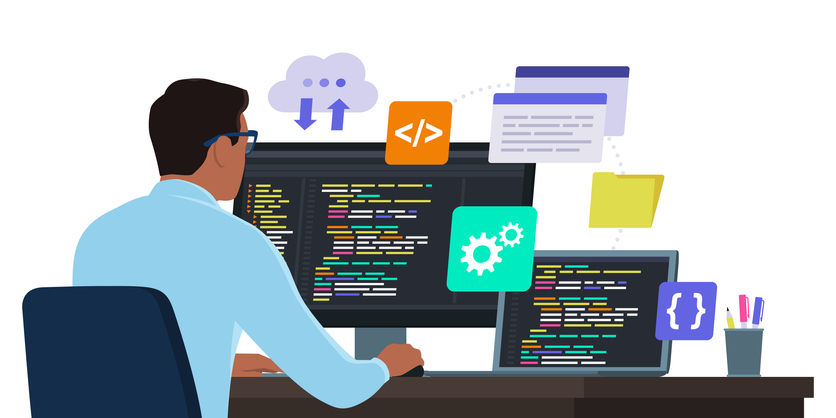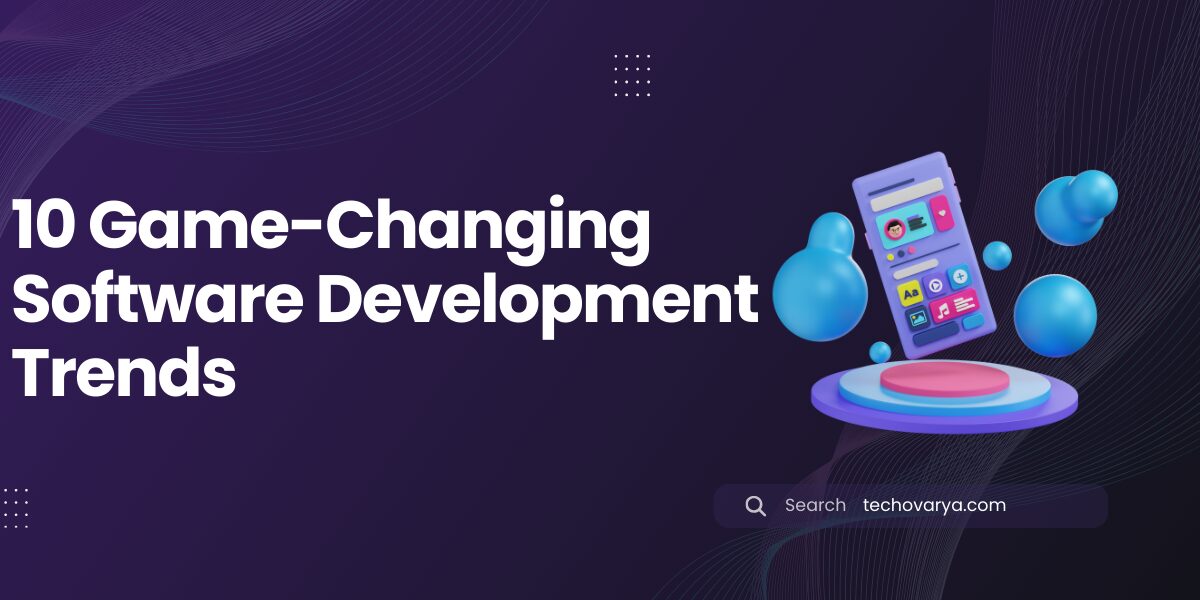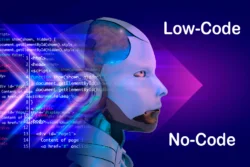The software development world is highly dynamic and this remains to be driven by factors such as the pace of technological improvement, customer requirements, and a necessity for more innovation. Developers and organizations must remain updated on the trends and adopt the right developments that would enhance their operations as well as provide effective services to users. Techovarya, a Leading Custom Software Development Services provider, is at the forefront of these transformative trends, delivering cutting-edge solutions that drive success for businesses across diverse industries.
What is a Software development?
Software development is a wider concept that encompasses the actual creation of software. It is not only about typing lines of code (which is at the heart of the process) but also involves defining problems, choosing approaches to solve the problems together with their implementation, etc. They cover the whole software development process, from the conception of the idea to its deployment and further use. Here’s a breakdown of the key stages
Here’s a breakdown of the key stages:
- Conception and Planning: This is the stage where the concept starts and the idea for the software originates from. Requirement gatherers, creators, and proposers identify the needs of the audience the software will address. They also pay attention to the practicality of the project and look at the implementation plan.
- Requirement Gathering: Stakeholders are assessed to determine how their needs will be met through the software. This involves the process of collecting known requirements from different stakeholders such as users and businesses as well as other teams. These requirements could be classified as user requirements (functional requirements, specific attributes), or attribute requirements (performance, security).
- Design and Architecture: According to the given requirements an architectural plan for the software is developed. This is on general architecture, the user interface (UI), and data flow / data management. Various functional and structural interfaces and how they are to be developed are determined here.
- Development (Coding): This is where the coding takes place and where the results will be generated by the program. Programmers employ multiple programming languages and tools to write the set source code that unleashes the software’s functionality. They then make interpretations of the design in functional code and make sure that the code written meets the set standard.
- Testing and Debugging: The written code is very much checked for errors known as bugs and appropriate rectification measures are made. Various strategies of testing are applied such as manual testing and automated testing to verify that the software operates properly as per the laid down standards.
- Deployment and Release: After the software has been tested it is released to an operational environment that can be accessed by users. This may sometimes include installing it in servers, app stores, or cloud platforms.
- Maintenance and Support: In fact, software development is a long process that doesn’t come to an end when the product is released. There is continuous improvement where developers patch up the gaps, add functionalities, enhance the speed, and even mend up breaches. There is also user support that is offered to ensure that users who experience any problem with the software are assisted.
Software development is a collaborative effort that involves various professionals, not just programmers. Here are some of the key roles:
- Software Developers (Programmers, Coders): Write the code that makes the software work.
- Software Engineers: Apply engineering principles to design, develop, and test software systems.
- Software Testers: Ensure the software functions correctly and identify and fix bugs.
- UI/UX Designers: Design the user interface (UI) and user experience (UX) to make the software user-friendly and intuitive.
- Project Managers: Oversee the entire software development process, manage resources, and ensure the project is delivered on time and within budget.
By understanding these different stages and the people involved, you’ll have a solid foundation for exploring the game-changing trends in software development for your blog post.
Top 10 Software Development Trends

1. Low-Code and No-Code Development Platforms
The need for digital solutions is growing. There is a greater need for faster and more efficient development. Low-code and no-code development platforms have changed the game. They let both developers and non-technical people build apps without coding. These platforms leverage:
- Visual interfaces
- Drag-and-drop components
- Pre-built templates and modules
Low-code and no-code platforms remove the difficulties of traditional coding. They enable faster application development and shorter time-to-market cycles. They also enable greater productivity. This makes them a significant asset for enterprises looking for agility and innovation.
2. Artificial Intelligence and Machine Learning
Artificial Intelligence (AI) and, more specifically, Machine Learning (ML) are already integral to the current state of software development. These technologies are revolutionizing software production, distribution, and use. They create more prospects mainly in several fields.
- Predictive analytics and intelligent decision-making
- Natural language processing for chatbots and virtual assistants
- Computer vision for image and video analysis
- Intelligent automation and process optimization
Hence, it becomes clear that developers can incorporate AI and ML in the solutions they build. They can utilize them to make smarter apps, custom ones, and efficient ones too. This will enhance user experience and also encourage advancements within the sector.
3. Cloud-Native Development
Globally, the cloud has changed the way software is developed, deployed, and administered. Some of the cloud-native development practices are containerization, microservices, and serverless development. They have gained popularity.
- Scalability and flexibility
- Reduced infrastructure costs
- Faster time-to-market
- Improved resilience and fault tolerance
New development for the cloud enables enterprises to design and deploy applications effectively. On the peripheral, they can benefit from the flexibility and scalability of the cloud resources. This lowers operational costs.
4. Continuous Integration and Continuous Deployment (CI/CD)
In the fast-paced world of software development, agility and speed are essential. CI/CD procedures have become critical. They help provide high-quality software quickly and reliably. This technique has various benefits:
- Reduced risk of errors and defects
- Accelerated time-to-market
- Increased collaboration and transparency
- Improved software quality and reliability
Organizations may improve their software delivery pipelines using CI/CD. This leads to faster releases and quicker responses to market needs.
5. Cybersecurity and Privacy by Design
Software systems are growing more networked. They manage sensitive data. This has made cybersecurity and privacy concerns more prominent. You must adopt a “security-first” and “privacy-by-design” strategy. These are critical for making safe and reliable systems. This involves:
- Implementing robust security measures
- Adhering to data protection regulations (e.g., GDPR, CCPA)
- Ensuring privacy considerations are baked into the software development lifecycle from the outset
- Conducting regular security audits and vulnerability assessments
They may reduce risks. They will also also be accorded the trust of the consumers. And, they will not have stressful situations involving costly losses of data and legal complications.
6. Progressive Web Applications (PWAs)
PWAs are emerging as one of the most innovative approaches in web development that we’ve seen in recent years. It’s important to note that these apps are a mix of the advantages found in native and online apps. It means that they provide a balanced and interesting interface across the devices. PWAs are distinguished by:
- Fast load times and responsive performance
- Offline functionality
- Push notifications and background sync
- Seamless installation and updates
PWAs embrace modern web tech. They stick to key architectural principles. They offer a great option for traditional native app development. They let developers make engaging, fast apps that work on all platforms.
7. Internet of Things (IoT) and Edge Computing
The Internet of Things (IoT) is becoming popular rapidly. The Internet of Things is an extensive network of connected devices generating massive amounts of data. Edge computing deals with data in a local environment instead of sending it to a central data center. Today, it has been adopted as a part of IoT systems.
- Designing applications that can efficiently handle and process data at the edge
- Ensuring low-latency performance for time-sensitive applications
- Implementing robust security measures to protect IoT devices and data
- Leveraging advanced analytics and machine learning for edge processing
The Internet of Things is growing. Developers will need to learn edge computing. This is to make IoT apps that are scalable, secure, and efficient. They will need these traits to use dispersed computing power.
8. Quantum Computing
Quantum computing is still in its early phases. It has huge potential. It can solve tough problems that regular computers can’t. Quantum computing technology is advancing. Writers must change their methods. They must use quantum algorithms to solve problems like:
- Cryptography and cybersecurity
- Optimization problems
- Simulation and modeling
- Machine learning and artificial intelligence
It would mean that with the help of quantum computing, developers can open something new. They can solve problems where solutions were previously inaccessible. This will bring about an increase in the rate of innovation in many sectors.
9. Sustainable Software Development
There are more environmental issues and concerns with the world around us. Thus, creative software development has reached the stage where it is called sustainable. This trend focuses on developing software that consumes the least amount of power so that it can achieve its tasks in the shortest time possible. This crms1 affects the reduction of resource consumption and its carbon footprint. Developers are investigating approaches such as Developers are investigating approaches such as:
- Green coding practices (e.g., optimizing algorithms, reducing memory usage)
- Optimizing data centers for energy efficiency
- Leveraging renewable energy sources
- Implementing software lifecycle management practices that consider environmental impact
Such organizations use sustainable software development. This may reduce their environmental impact. It can also encourage eco-friendly activities and help create a sustainable future.
10. Collaborative and Distributed Development
Remote work and scattered teams have increased. This has prompted a shift to collaborative and distributed development. Tools and platforms enable communication, coordination, and version control. They have become critical to ensure smooth collaboration and efficient software development. This trend includes:
- Embracing agile methodologies and fostering open communication
- Leveraging cloud-based tools for project management, code repositories, and real-time collaboration
- Implementing robust version control systems and code review processes
- Fostering a culture of knowledge sharing and mentorship across distributed teams
They may access a global talent pool. They can foster diversity and creativity. They ensure smooth cooperation despite team members’ physical locations.
What is the Current Latest Trend in the software development industry?
One of the latest trends that has gained significant traction is the rise of low-code and no-code development platforms.
Low code and no code platforms enable the creation of applications without requiring a lot of coding, and in most cases hardly any coding at all by developers or users who may not have any coding skills. These tools offer graphic tools for customizing planned applications and helping the user place defined elements together like puzzle pieces, modify the workflow of delivered tasks, and define the application’s business logic.
The main motivation for utilizing low-code and no-code platforms is the time constraint for application development and the inability of the business department to work jointly with the IT department. These platforms make the development process easier and flexible for organizations to model, develop, and deploy applications within a short period without necessarily having to employ a team of developers.
Conclusion
Software development is changing. It’s fueled by technical advances, growing customer needs, and the quest for innovation. By adopting these ten game-changing trends, developers and organizations can stay ahead. They can give great user experiences. They can achieve long-term success in a more competitive digital market. Adopting these trends improves software development. It also creates new potential for creativity, cooperation, and long-term success. Successful firms will embrace these trends. They will create a culture of learning. They will adjust their strategy to fit the changing market.
FAQ
Q- What are low-code and no-code platforms?
A- They allow building applications with little or no coding using visual interfaces and pre-built components.
Q- How can AI and ML be used in software development?
A- For predictive analytics, natural language processing, computer vision, and intelligent automation.
Q- What are the benefits of cloud-native practices?
A- Scalability, reduced costs, faster time-to-market, improved resilience.
Q- Why adopt CI/CD pipelines?
A- To reduce errors, accelerate releases, increase transparency, and improve quality.
Q- What is “privacy by design”?
A- Implementing robust security and ensuring privacy from the start of the development lifecycle.
Q- What are the advantages of PWAs?
A- Fast loading, offline functionality, push notifications, cross-platform support.
Q- Why is edge computing important for IoT?
A- To efficiently process data locally for low-latency and secure IoT applications.
Author Bio:
Hemant Jani, CEO at Techovarya, is a tech enthusiast who loves to write about the latest innovations. With a proven track record of over 40 successful projects in SAAS, Web, and Mobile App Development, he’s a seasoned expert in the field. Starting with a small team of three partners in 2015, Hemant has expanded Techovarya into a thriving team of 16 professionals. Beyond his entrepreneurial endeavors, he finds joy in sharing his tech insights through his writing.






